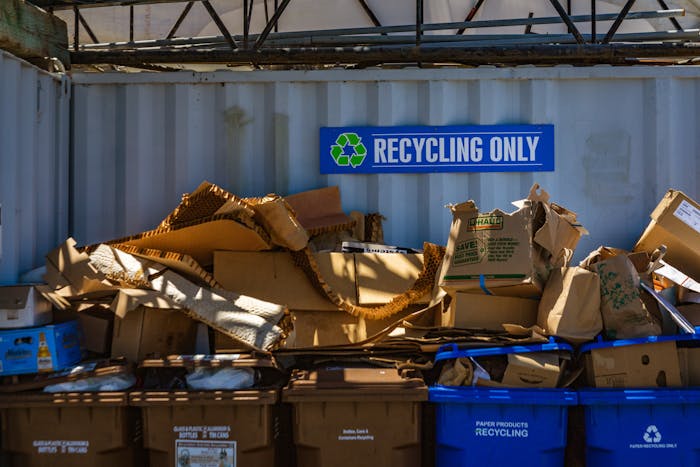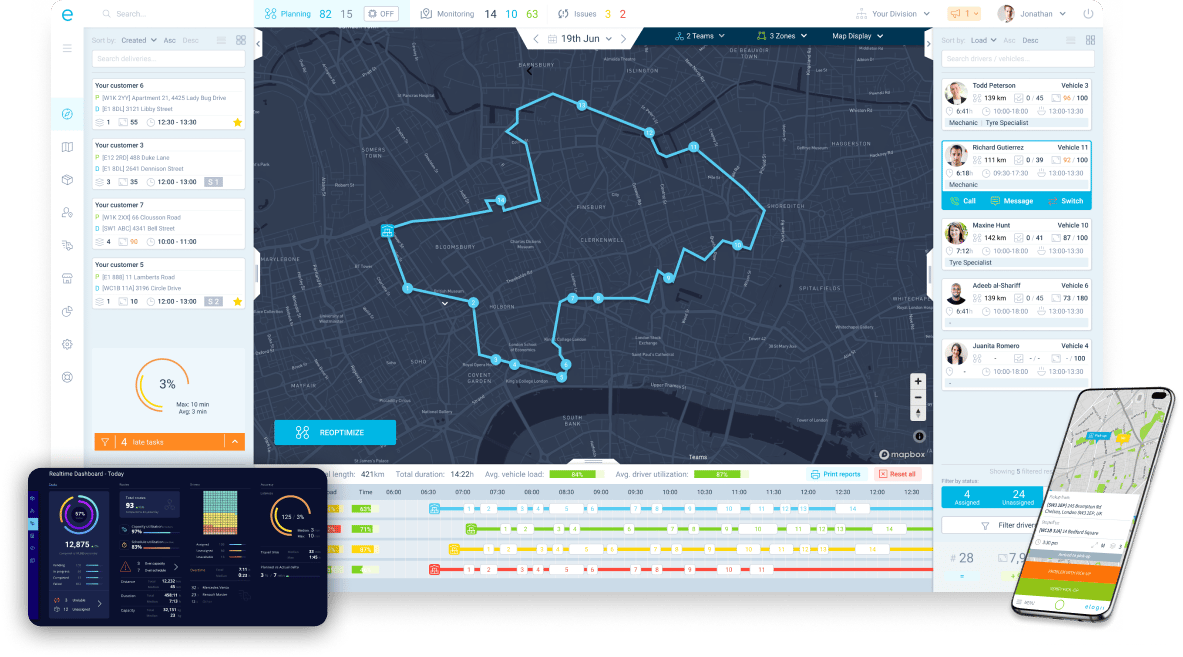Starting a waste collection business can be lucrative, especially in a growing industry like waste management.
With a bit of business know-how, the right tools, and the best route optimization software, savvy entrepreneurs and ambitious side hustlers can turn cash into profit.
In this article, we’ll share six key steps to start a waste collection business. We'll show you how route optimization software can help you expand and scale easily.
The Projected Growth of the Waste Collection Business
The market size of the Waste Collection Services industry in the United States is projected to reach $77.1 billion by 2025. The industry presents a huge opportunity for entrepreneurs and anyone seeking a scalable side hustle.
Namely, the Environmental Protection Agency says the U.S. creates over 292 million tons of waste each year, about 4.9 pounds per person per day.
There’s never been a better time to start a waste collection business.
Step 1: Pick a Waste Industry Sector
Not all trash is the same. To start your waste management business in 2025, first decide which types of waste materials you’ll collect and transport.
Different sectors may benefit from waste hauling business optimization and waste collection route planning to improve efficiency and reduce costs. Here are a few options:
- Medical: Waste from places like nursing homes, dental offices, hospitals, and vet clinics.
- Construction: Waste from building sites, often containing hazardous materials like paint and asbestos that need special handling.
- Electronic: Old electronics, such as household appliances, toys, computers, and batteries.
- Green: Organic waste, like garden clippings, that can be composted.
- Animal/Pet: Waste from yards, litter boxes, and places like equestrian facilities.
- Industrial: Waste from factories, mines, and mills, often needing special care.
- Nuclear: An emerging sector involving waste from nuclear power plants.
If you’re unsure which industry fits you best, look into the waste needs of your local area or where you plan to operate.

Step 2: Create a Simple Business Plan
Every business needs a solid plan to start. By sitting down and writing out your goals and plans, you can avoid a lot of confusion that often comes with starting a new business. Plus, you’ll have a handy document to ensure your business stays on track and heads in the right direction as it grows.
For instance, your business plan should outline how you will leverage waste collection optimization tools and waste collection efficiency tools to streamline operations and enhance service delivery.
Consider these questions when making your business plan:
- What’s your business structure (sole proprietorship, partnership, LLC, or incorporated)?
- What are the clear goals and objectives for your waste management business?
- Who are your target customers, and what problem are you solving for them?
- Do you have any competitors in your industry? How is your service different or better?
- How does your pricing compare with other waste collection and management businesses?
- How will you market and grow your business?
- What are your startup costs?
For help with your waste collection business plan, check out resources from the U.S. Small Business Administration on business plans, market research and competitive analysis, and calculating startup costs.
Step 3: Register Your Business and Get the Right Permits
Once you've picked your industry and crafted a business plan, it’s time to make it official. Check your state and local government rules to see which permits you’ll need to run your waste collection business legally in 2025.
Depending on your business structure, you may need to register with local, state, and federal government agencies. At a minimum, get an Employer Identification Number from the IRS for tax purposes. Then, consult local and state environmental and waste agencies to find out which permits you need to transport waste and use the right landfills and waste management facilities.
For instance, in California, medical waste transporters must register with the California Department of Public Health, get a Hazardous Waste Registration certificate, and have liability insurance.
In New York, construction debris haulers need a city license, a Waste Transporter Permit from the state, and a registration for the removal of Construction and Demolition Debris.
Don’t skip this crucial step! Running your business without the proper permits could lead to big problems.
Step 4: Buy the Equipment You Need
You don’t need a giant trash truck to run a successful waste collection business. A mid- to full-size van or pickup truck works just fine. Depending on the industry you pick, you might also want extra equipment to get the job done safely and efficiently. Even more so, you should consider investing in waste collection fleet optimization software to ensure your fleet operates at maximum efficiency, reducing fuel costs and improving service reliability.
Here’s a quick list of gear to consider before you start:
- Heavy-duty gloves
- Safety glasses
- Earplugs
- Masks/respirators
- Shovels
- Rakes
- Hand saws
- Brooms and dustpans
- Trash bags and cans
- Dumpster and compactor
- Cleaning and sanitation equipment
- Vehicle maintenance kit
The last thing you want is to arrive at a pickup site without the right gear. Always check what each route or worksite needs and plan ahead.
Step 5: Promote Your Waste Collection Business
Without customers, your waste management business won’t take off. To grow your customer base in 2025, focus on building a strong online presence and networking in person.
Build a Strong Online Presence
Your website, Google My Business listing, social media platforms, and paid advertising are key to your business’s success. Here’s how to get started:
- Use a website builder like Wix to create a professional website quickly without needing a web designer or any coding skills.
- Set up a Google My Business page to put your business on the map and appear in local online search listings (make sure your name, address, and phone number are the same across all digital platforms!).
- Create a Facebook Business Page to give your business a personal touch.
- Finally, think about using paid advertising like Google Ads and Facebook Ads to get your waste collection business in front of the right people fast.

Get to Know Customers and Local Businesses
In-person networking is a great way to attract customers to your new waste management business. Create business cards and flyers to hand out whenever you get the chance. Based on the industry you chose in Step 1, focus on local businesses that could use your services and meet with them face-to-face. Even if they don’t hire you immediately, making a personal, positive impression will keep you in mind for future opportunities.
Step 6: Plan Efficient Routes for Your Waste Collection Team
Great news! Your business is picking up, and new customers are joining. But as you check the maps to plan the best routes for waste pickups and landfill trips, you might be scratching your head over which route works best. And with each new customer, you need to update and adjust the route.
Why not let our software do the planning for you?
With eLogii, just enter your customers’ addresses and get the most time- and cost-effective pickup and drop-off routes instantly. Our platform specializes in waste collection optimization, ensuring every route is the best it can be. Using route optimization software from the start sets you up to grow your business with ease in 2025. You can efficiently route hundreds of stops for a large fleet without spending extra time planning.

Waste collection businesses of any size can save time, money, and avoid the hassle of mapping routes by using eLogii. Whether you're managing a waste hauling business optimization project or simply looking for better waste collection route planning, eLogii has you covered.
eLogii also helps other industries, like supply distributors and field services, by optimizing routes for maximum efficiency. These examples show how eLogii can streamline operations and improve service, giving waste collection businesses the same benefits and more.
Heatleys Safety & Industrial: Philip Podgorski, Chief Development Officer at Heatleys, praises eLogii for its advanced, flexible route optimization and user-friendly interface for both drivers and fleet managers. Since switching to eLogii, Heatleys has seen notable benefits, including increased revenue from later cut-offs and more orders, an 80% reduction in planning and scheduling time, and less reliance on manual processes and paperwork. Customer satisfaction has improved significantly due to enhanced tracking and live ETAs, while customer inquiries about order statuses have decreased. The seamless API integration with their ERP system has further boosted efficiency and allowed the fleet manager to focus on enhancing the customer experience.
ATS Building Products: Alex Sohler, Chief Operating Officer, highlights eLogii's intuitive interface and accurate performance, noting improvements in analytics and easy implementation. Since adopting eLogii, ATS has seen a 98%+ increase in deliveries per route, a 43% drop in customer inquiries about order status, and a 23% boost in customer satisfaction due to better tracking and updates. The integration with their existing ERP system and the automation of routes have streamlined operations and cut costs, while enhanced visibility and analytics have improved performance and customer service. Drivers benefit from a powerful app that simplifies their tasks, and the management team gains valuable insights to drive continuous improvement.
Here’s what else eLogii offers:
- A complete web and app-based system, so you won’t need to install any bulky software or equipment.
- A driver’s app that updates locations and destinations in real time, eliminating the need for Excel printouts or manual address entry.
- Use both past and current traffic data for specific vehicle types to plan accurate routes.
- Live Tracking so dispatchers can see technicians’ locations in real time.
- A Proof of Service feature that allows drivers to take and upload photos of completed jobs.
- Last-minute change functions that let you quickly add or remove addresses and update your route instantly.
- Waste collection optimization apps, like eLogii, bring advanced features that enhance route planning and efficiency.
- Bin collection optimization becomes straightforward with eLogii, thanks to its intelligent algorithms and real-time updates.
- Our waste collection optimization tools are designed to streamline operations and boost productivity, making route planning simpler and more effective.
Optimization is the Key to Success
The most successful waste collection businesses know that optimizing routes is crucial for profitability in 2025. Efficient route planning reduces fuel costs, saves time, and ensures timely pickups, which can significantly enhance customer satisfaction.
You don’t want to be bogged down with maps and spreadsheets, scrambling to calculate routes for your new business. Manual planning can lead to inefficiencies and missed opportunities. Instead, leverage eLogii's advanced route optimization software, which uses intelligent algorithms to find the best route for you every time. This allows you to focus on growing your business and turning trash into cash with minimal hassle.
By streamlining your operations, you'll not only increase your bottom line but also gain a competitive edge in the waste collection industry.
Conclusion
All in all, starting a waste collection business in 2025 offers great potential, especially with the industry's projected growth. Key steps include selecting a waste sector, creating a business plan, obtaining necessary permits, acquiring the right equipment, and promoting your services.
Efficient route planning is crucial, and using trash collection optimization software like eLogii can save time and costs while boosting customer satisfaction. By following these steps and leveraging advanced technology, entrepreneurs can streamline operations and build a profitable waste management business.